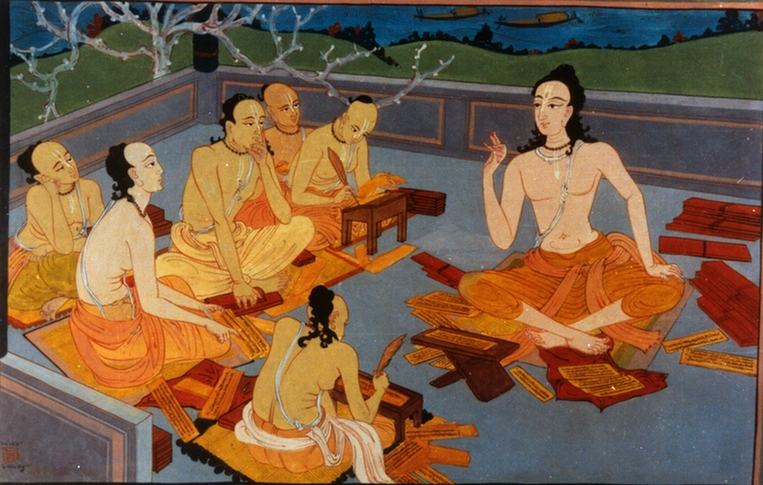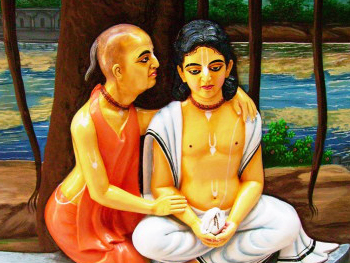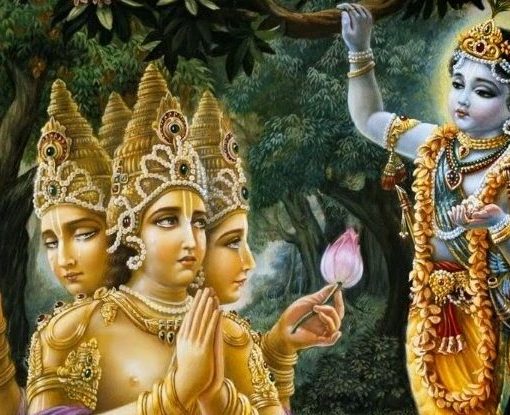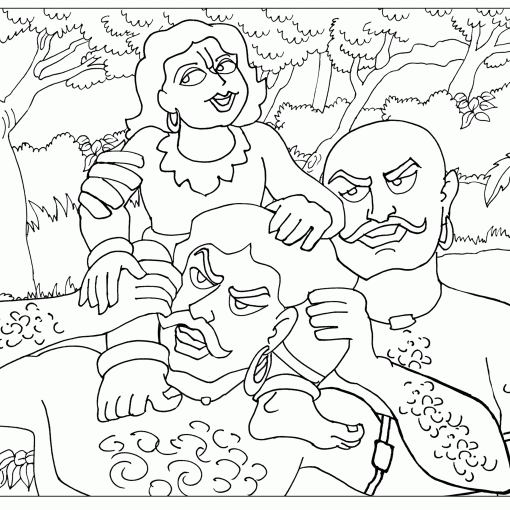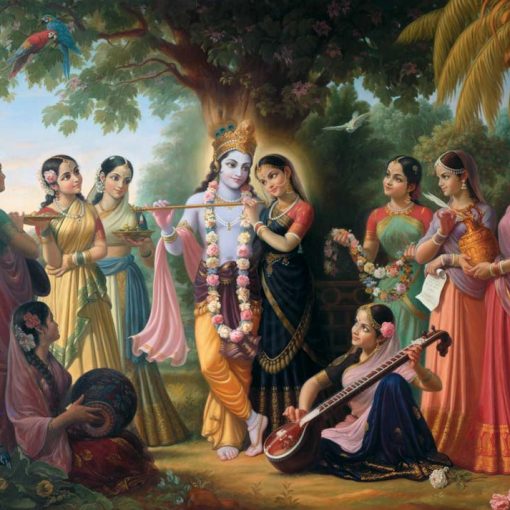Although some of His followers were older, Lord Caitanya Himself was very young when He began teaching—He was a child prodigy. By the age of eleven Lord Caitanya was the equivalent of a Ph.D., and became the professor of His own school. At this young age He was already one of the greatest teachers in India.
By the time He was about 14, He was very famous, and was known as Nimāi Paṇḍita. He had thousands of students. He would sit by the side of the Ganges and all the students would be around Him, and He would teach them the Sanskrit grammar, Sanskrit kavi (poetry), and all the different aspects of Sanskrit, śāstra, nyāya, different methods of coming to proper logical conclusions and debating. He was very strict and made sure that all his students followed their daily sādhana—chanting their Gāyatrī and putting on tilak. Gāyatrī mantra is especially important in our spiritual development—it helps us to control the mind, and helps us to be able to meditate on the Lord. It is recommended that we have the Gāyatrī mantra. Prabhupāda said that it is not absolutely essential—we could go back to Godhead just by chanting Hare Kṛṣṇa, Hare Kṛṣṇa, Kṛṣṇa Kṛṣṇa, Hare Hare/ Hare Rāma, Hare Rāma, Rāma Rāma, Hare Hare—but the Gāyatrī mantra is very helpful for our spiritual progress. The Gāyatrī mantra is also non-different from Kṛṣṇa: the Kāma-gāyatrī is non-different from the flute sound of Kṛṣṇa. The pāñcarātrika mantras help us in our spiritual progress and most of the associates of Lord Caitanya chanted their Gāyatrī mantra. In brahminical culture one first gets upanayanam. Upanayanam is the first Gāyatrī that we get in our Gāyatrī mantras. Generally, it is given to the children studying the Vedas, and later on they get the other pāñcarātrika mantras when they are more mature in their spiritual life. Lord Caitanya insisted that everybody should wear tilak when they come for class. If somebody showed up without wearing tilak, He had them stand up in front of all the other students, which is very humiliating. He would say, “Why don’t you have tilak? Without tilak your forehead is like a crematorium. It means you must not have taken your morning bath, chanted your Gāyatrī mantra. If you had done all these things then you would have your tilak. It is part of the morning duties.” Then the Lord sent them back home.
So the student would go take his bath, put on his tilak, say Gāyatrī and then come back to school. Due to that kind of embarrassment the students were careful to always come with tilak and having chanted their mantras. After a couple people like that were sent back home, everybody would come with tilak—Lord Caitanya insisted on these things.
To study the Vedas, you have to also purify your mind with the Gāyatrī mantra. Gāyatrī purifies the mind so we can think more purely about Kṛṣṇa. And in order to chant Gāyatrī properly, first one has to chant Hare Kṛṣṇa, Hare Kṛṣṇa, Kṛṣṇa Kṛṣṇa, Hare Hare/ Hare Rāma, Hare Rāma, Rāma Rāma, Hare Hare, and get purified, then one can effectively chant the Gāyatrī mantras, which then help us to advance further in our Kṛṣṇa consciousness.
Tilak is a way of dedicating our body to be a temple—keeping Kṛṣṇa in the heart. It is mentioned in the Vedas as dvādaśa-ūrdhva-puṇḍra. There are different kinds of tilak, but when the tilak is going up it is called ūrdhva, and dvādaśa means twelve—there are twelve parts of the body that we place tilak on with different mantras.
Devotees, especially those who are sheltered or initiated, should put on tilaka. If you can’t put on gopī-candana tilaka because you have to go to work or something, you can put it on with water, but you should say the mantras. The mantra is what gives you the protection of Kṛṣṇa.
There is a whole chapter in the Padma Purāṇa about gopī-candana tilaka. In the spiritual world, and even in some celestial planets, everybody wears tilaka. It is the sign that they are Vaiṣṇavas, devotees, bhaktiyogīs. When somebody sees the tilaka, it reminds them of the spiritual world—it has a very purifying effect.
Gauranga – The golden incarnation of divine love- HH Jayapataka Swami

